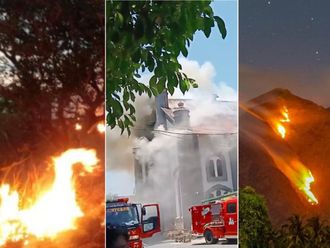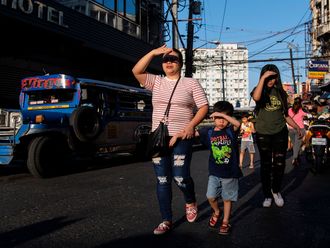
Manila: Former communist leaders turned sentimental when divers found a sunken vessel that brought thousands of arms from China to members of the Communist Party of the Philippines and its military arm, the New People’s Army in northern Luzon in 1972, a TV documentary said.
“I remember this,” said Victor Corpuz, as he touched a hole at the metallic skeleton of MV Karagatan during a dive off Digoyo Point in Isabela, the footage of which was shown by I-witness, a production of broadcast journalist Howie Severino for GMA News.
Corpuz referred to a stockpile of thousands of M14 rifles, rocket-propelled grenades, high-powered war-materiel, ammunition, and communication equipment that China shipped to the Philippines for the first time on board a Japanese vessel that was renamed “Karagatan,” a Filipino word for the sea.
In July 1972, Corpuz recalled that he and nine other comrades trekked for 71 days at the highest point of the Sierra Madre, not on the road but deep in the forest, to reach Digoyo Point, an isolated portion in Isabela to implement the grand arms landing.
“For several days, we were eating only coconut meat,” recalled Corpuz,
At the beach, Corpuz almost embraced a big rock, and said, “This was the rock [where I hid during a firefight with troops that were brought in by a Navy boat, after the weapons were unloaded on the beach. The clash prevented the arms landing from becoming successful].”
A small plane had seen the beginning of the arms landing and quickly reported to the military.
Military men, led by a former student of Corpuz at the Philippine Military Academy (PMA, the country’s West Point), fired at the communist rebels. After several minutes, the communists rushed inside the Sierra Madre forest, toting just a thousand of arms from China.
With the help of the Dumagats, an ethnic group, the rebels survived the forest of the Sierra Madre. “It was fatal to be lost inside that dangerous forest,” said Corpuz.
In the documentary, Monico Molina, a Dumagat, an ethnic group in the area, who helped Corpuz and company, beamed with happiness when he saw Corpuz again. Both of them had grown old since 1972.
“I was imprisoned for a month because the authorities thought I was a major participant in that incident,” said Molina.
When asked why M/V Karagatan sank, Molina said, “Typhoons. Then it was swallowed by the sea.” He did not say if the rest of the arms were taken by the military.
Had the arms-landing succeeded, Corpuz analysed, “We would have a different form of government by now.”
On December 29, 1970, Corpuz was a tall, lanky, dark, and a handsome cadet lieutenant who raided the armoury of his alma mater, the Philippine Military Academy (PMA) before he joined and became a member of the central committee of CPP-NPA that was established by Jose Maria Sison, a former English professor at the premier University of the Philippines in 1965.
It was the second generation of communists in the Philippines.
The failed arms landing off Isabela in 1972, and the bombing of the Liberal Party (then opposed to President Ferdinand Marcos) at Manila’s Plaza Miranda which killed 95 people and injured hundreds on August 21, 1971, prompted Marcos to declare a Martial Law rule on September 22, 1972.
Corpuz surrendered in 1976, was imprisoned and eventually released by former President Corazon Aquino, following the ouster of Marcos by a people-backed military mutiny in 1986.
During the time of former President Fidel Ramos, from 1992 to 1998, Corpuz was reinstated with the rank of Lieutenant Colonel. He retired a Brigadier General after heading the Intelligence Service of the Armed Forces of the Philippines. He eventually became an environmentalist.
Also interviewed by Severino’s documentary was Ricardo Malay, a young student who ventured to China in the 70s. Sison, the CPP-NPA founder, asked for arms and monetary support from China’s communist Chairman Mao Tse-Tung, recalled Malay. At the time, China was sending arms to Vietnam and other Third World countries that embraced the leftist ideology.
In a column he wrote for the Inquirer in March 2005, Malay also said, “Mao approved the coming of the CPP mission (that included me), in a letter to Sison (which was) relayed through Kang Sheng, the most powerful member of the Chinese Communist Party’s politburo.”
Geng Biao, the minister in charge of China’s relations with global revolutionary movements, was behind the approval of Sison’s request from Mao, said Malay.
But after the failed arms — landing off Isabela in 1972, “in 1974, our (Philippine) mission (in China) suffered another setback. Our next vessel, the M/V Andrea, was on its way to the Sanya Naval Base to load hundreds of automatic rifles in sealed plastic tubes, when it was shipwrecked in the South China Sea,” recalled Malay.
China stopped supporting the CPP-NPA following the establishment of diplomatic ties between China and the Philippines on June 9, 1975.
In 1992, the Philippine government began holding peace talks with the communist National Democratic Front (NDF), which represented the CPP-NPA. Negotiations are still ongoing.











